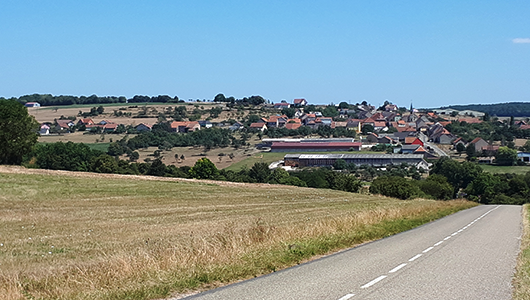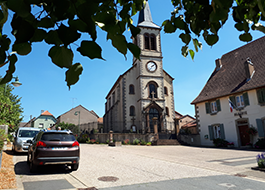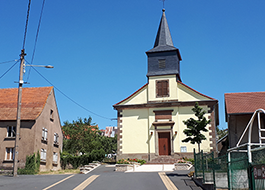Postroff
Durée visite : 30 minutes
Moyen : Pédestre
Son nom vient d’une personne germanique, Boso et dorf, village. Postroff appartenait à la seigneurie de Fénétrange-Géroldseck. La Réforme y fut introduite. Cela entraîna des frictions avec les catholiques voisins. Ils surnommèrent les Postroffois Steenbeck. C’est un jeu de mot entre les mots bouc et réprouvé. La commune passa à la France en 1766. On y compte 210 habitants en 2018.
Its name comes from a Germanic person, Boso and dorf, village. Postroff belonged to the lordship of The Strange-Geroldseck. The Reformation was introduced. This led to friction with neighbouring Catholics. They nicknamed the Postroffois Steenbeck. It’s a pun between the words goat and reprobate. The commune passed to France in 1766. It has a population of 210 in 2018.
Sein Name stammt von einer deutschen Person, Boso und Dorf, Dorf. Postroff gehörte der Lordschaft von Fénétrange-Geroldseck. Dort wurde die Reformation eingeführt. Das führt zu Reibungen mit den benachbarten Katholiken. Sie nannten die Postroffois Steenbeck. Es ist ein Wortspiel zwischen den Worten Bock und Verworfen. Die Gemeinde wurde 1766 nach Frankreich übergeschritten. 2018 leben dort 210 Menschen.

D’argent semé de billettes d’azur, au mont à trois coupeaux sommé d’une croix haute de gueules brochant sur le tout.
Silver strewn with azure logs, the three-cup mount with a high cross of mouths grinding over the whole.
Silber gesät mit azurblauen Fäden, auf dem Drei-Schalen-Berg, mit einem hohen Kreuz von Maulen geschnurzt auf alles.

Les habitants de Postroff s’appellent les Postroffois et les Postroffoises.
The inhabitants of Postroff are called postroffois and Postroffoises.
Die Einwohner von Postroff heißen die Postroffois und die Postroffoises.
Les points de visites
.
Elle est bâtie en 1883, en remplacement de celle du XVe siècle. Son style est néo-roman. Sur la gauche de l’entrée se situe une croix mémorielle. Elle rappelle les paroissiens tombés en 14-18. Ils servaient dans l’armée allemande. Les beaux vitraux sont des dons des fidèles. A noter celui de Sainte Eulalie, armée d’une épée, offert par la baronne de l’Espée. L’autel est décoré de scènes bibliques. Le 14 septembre est la fête de la Croix. Cet objet méprisable est devenu synonyme de gloire chez les chrétiens. Ce jour-là, on célèbre la découverte de la Vraie Croix par Hélène, mère de Constantin, en 335. Volée par les Perses à Jérusalem, elle fut reprise par Héraclius, empereur byzantin au VIIe siècle. L’église est sous son patronage.
It was built in 1883, replacing the 15th century. His style is neo-Romanesque. On the left of the entrance is a memorial cross. It recalls the parishioners who fell in 14-18. They served in the German army. The beautiful stained glass windows are gifts from the faithful. Note that of Saint Eulalie, armed with a sword, offered by the Baroness of The Espe. The altar is decorated with biblical scenes. September 14 is the Feast of the Cross. This despicable object has become synonymous with glory among Christians. On this day, we celebrate the discovery of the True Cross by Helen, mother of Constantine, in 335. Stolen by the Persians in Jerusalem, it was taken over by Heraclius, a Byzantine emperor in the 7th century. The church is under his patronage.
Sie wurde 1883 als Ersatz für die aus dem 15. Jahrhundert erbaut. Sein Stil ist ein Neo-Roman. Auf der linken Seite des Eingangs befindet sich ein Erinnerungskreuz. Sie erinnert an die Gemeindemitglieder, die in 14-18 gefallen sind. Sie dienten in der deutschen Armee. Die schönen Glasfenster sind Gaben der Gläubigen. Bemerkenswert ist das Schwert der Heiligen Eulalia, die von der Baronin der Espée geschenkt wurde. Der Altar ist mit biblischen Szenen verziert. Am 14. September ist das Fest des Kreuzes. Dieses verabscheuungswürdige Objekt wurde zum Synonym für Ruhm unter den Christen. An diesem Tag wird die Entdeckung des Wahren Kreuzes durch Hélène, die Mutter von Konstantin, im Jahr 335 gefeiert. Sie wurde von den Persern in Jerusalem gestohlen und von Herakus, einem byzantinischen Kaiser im 7. Jahrhundert, übernommen. Die Kirche steht unter ihrer Schirmherrschaft.
.
.
De 1565 à 1685, les protestants occupèrent l’église catholique. Les jésuites ramenèrent ensuite les habitants au culte romain. Au début du XIXe siècle, les luthériens réapparurent. Ils firent construire une église en 1834. le sarrebourgeois François Pierson en fut l’architecte. Elle emploie des matériaux typiques de la région: grès bigarré rosé, clocheton recouvert d’ardoises, toit à long pans et croupe recouverts de tuiles en écaille. Elle abrite un orgue du début du XXe siècle. Il fut construit par Adrien Spamann. Pour les amateurs, sachez qu’il est composé de 6 jeux sur un clavier manuel de 54 notes, ainsi que d’une soubasse à la pédale de 27 notes. La transmission des notes et des jeux est pneumatique. 412 petits soufflets assurent ce rôle. En 2020, la restauration a été effectuée par Koenig, manufacturier d’orgues à Sarre-Union depuis 1945.
From 1565 to 1685, Protestants occupied the Catholic Church. The Jesuits then brought the inhabitants back to Roman worship. At the beginning of the 19th century, Lutherans reappeared. They built a church in 1834. The Sarrebourg native François Pierson was the architect. It uses materials typical of the region: pink coloured sandstone, slate-covered bell, long-sided roof and rump covered with scale tiles. It houses an organ from the early 20th century. It was built by Adrien Spamann. For fans, know that it consists of 6 games on a manual keyboard of 54 notes, as well as a 27-note pedal soubasse. The transmission of notes and games is pneumatic. 412 small bellows provide this role. In 2020, the restoration was carried out by Koenig, an organ manufacturer in Saarland-Union since 1945.
Von 1565 bis 1685 besetzten die Protestanten die katholische Kirche. Die Jesuiten brachten dann die Bewohner zum römischen Kult zurück. Zu Beginn des 19. Jahrhunderts tauchten die Lutheraner wieder auf. Sie ließen 1834 eine Kirche bauen. Der Saarburger François Pierson war dessen Architekt. Sie verwendet für die Region typische Materialien: bunte Rosé-Sandstein, mit Schiefer bedeckte Clocheton, Langesdach und mit Schuppenziegeln bedeckte Rumpf. Sie beherbergt eine Orgel aus dem frühen 20. Jahrhundert. Es wurde von Adrien Spamann gebaut. Für Amateure, wissen Sie, dass es besteht aus 6 Spielen auf einer manuellen Tastatur mit 54 Noten, sowie eine Pedal-Soubasse mit 27 Noten. Die Übertragung von Noten und Spielen ist pneumatisch. 412 kleine Bläser sorgen für diese Rolle. Im Jahr 2020 wurde die Restaurierung von Koenig durchgeführt, seit 1945 Orgelfabrik im Saarland-Union.







